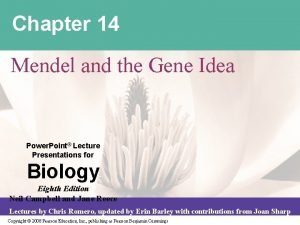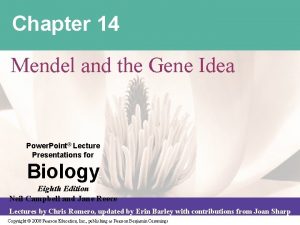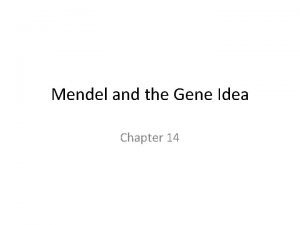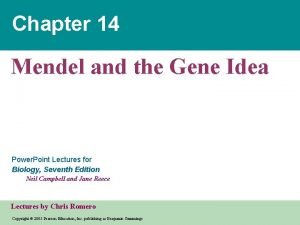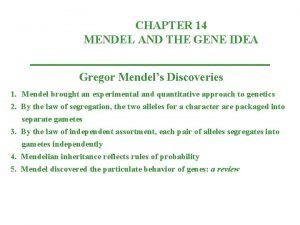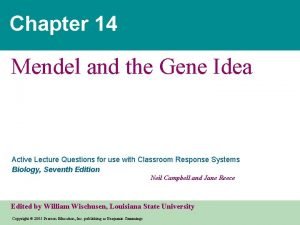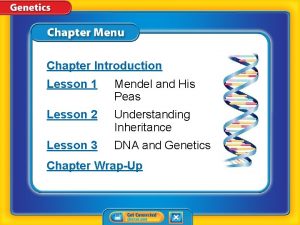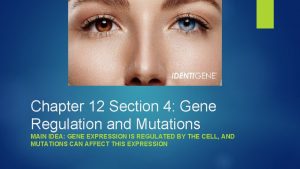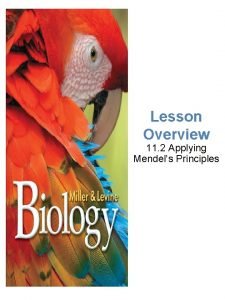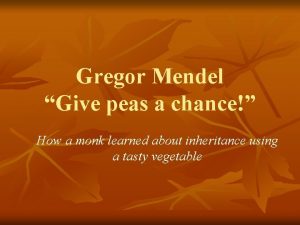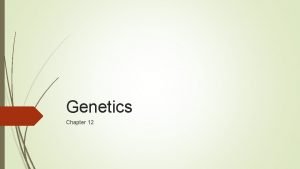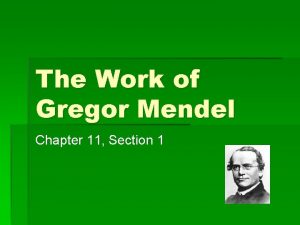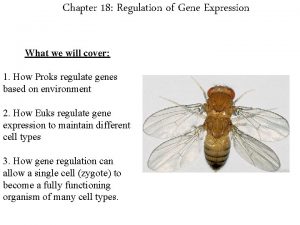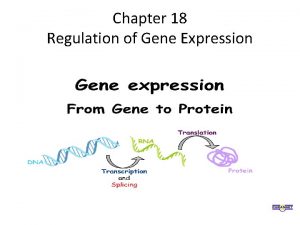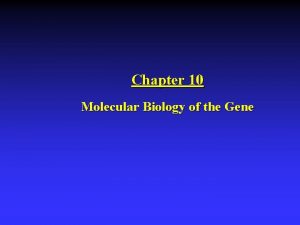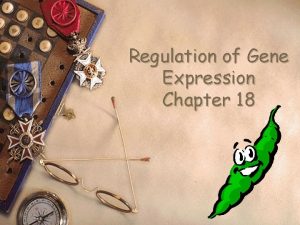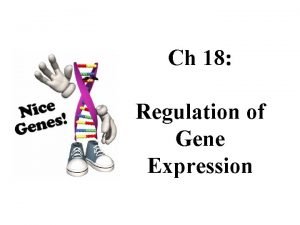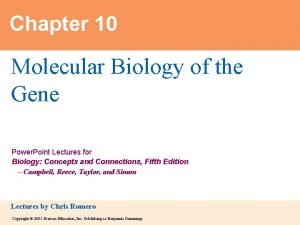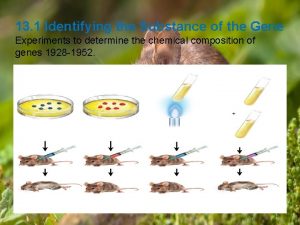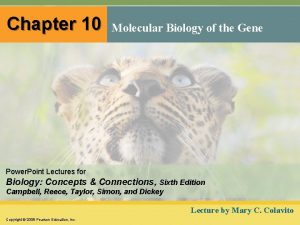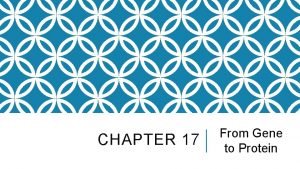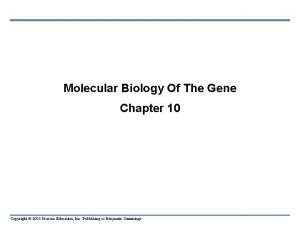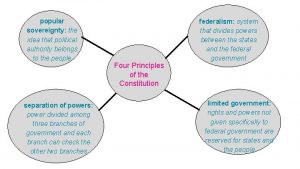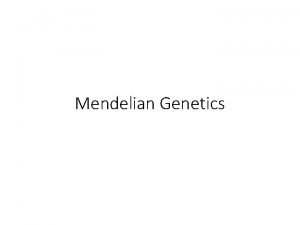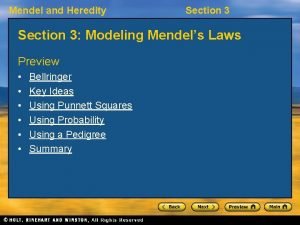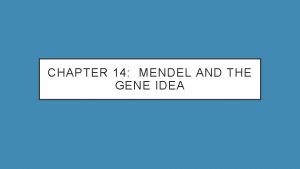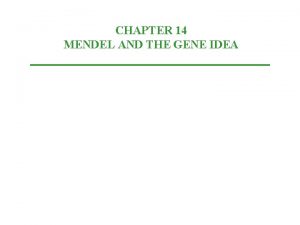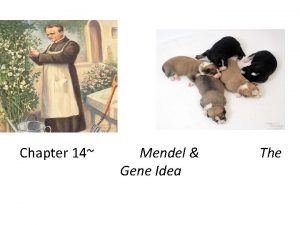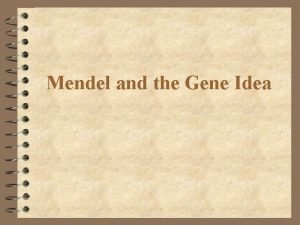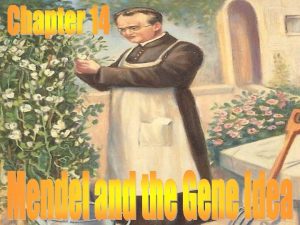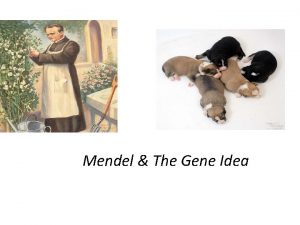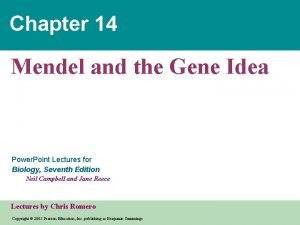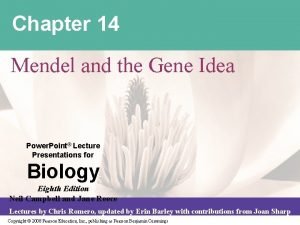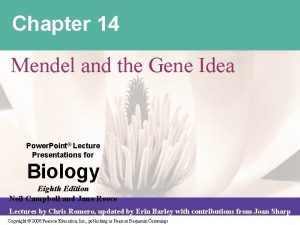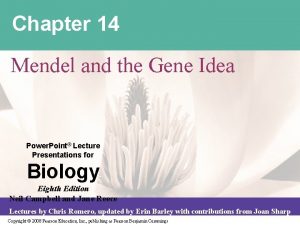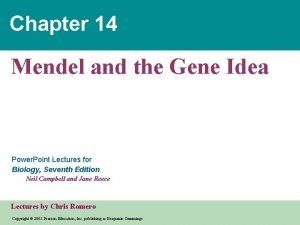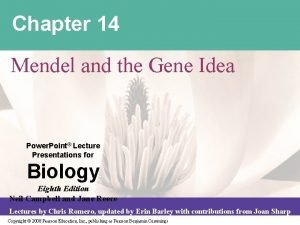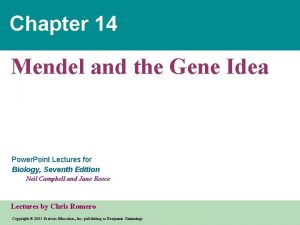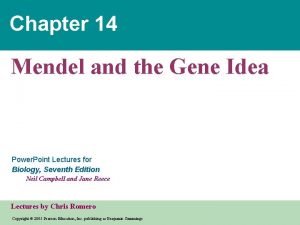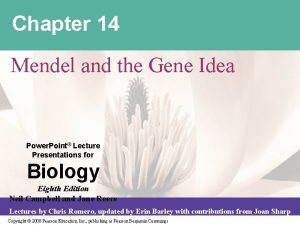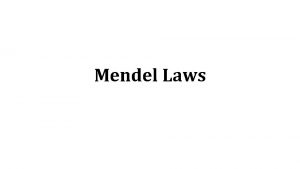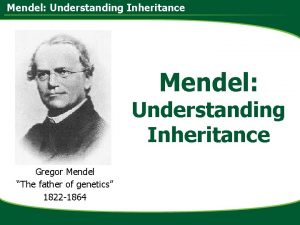Chapter 14 Mendel and the Gene Idea Power























































































- Slides: 87

Chapter 14 Mendel and the Gene Idea Power. Point® Lecture Presentations for Biology Eighth Edition Neil Campbell and Jane Reece Lectures by Chris Romero, updated by Erin Barley with contributions from Joan Sharp Copyright © 2008 Pearson Education, Inc. , publishing as Pearson Benjamin Cummings

Overview: Drawing from the Deck of Genes • What genetic principles account for the passing of traits from parents to offspring? • The “blending” hypothesis is the idea that genetic material from the two parents blends together (like blue and yellow paint blend to make green) Copyright © 2008 Pearson Education Inc. , publishing as Pearson Benjamin Cummings

• The “particulate” hypothesis is the idea that parents pass on discrete heritable units (genes) • Mendel documented a particulate mechanism through his experiments with garden peas Copyright © 2008 Pearson Education Inc. , publishing as Pearson Benjamin Cummings

Concept 14. 1: Mendel used the scientific approach to identify two laws of inheritance • Mendel discovered the basic principles of heredity by breeding garden peas in carefully planned experiments Copyright © 2008 Pearson Education Inc. , publishing as Pearson Benjamin Cummings

Mendel’s Experimental, Quantitative Approach • Advantages of pea plants for genetic study: – There are many varieties with distinct heritable features, or characters (such as flower color); character variants (such as purple or white flowers) are called traits – Mating of plants can be controlled – Each pea plant has sperm-producing organs (stamens) and egg-producing organs (carpels) – Cross-pollination (fertilization between different plants) can be achieved by dusting one plant with pollen from another Copyright © 2008 Pearson Education Inc. , publishing as Pearson Benjamin Cummings

Fig. 14 -2 a TECHNIQUE 1 2 Parental generation (P) Stamens Carpel 3 4

Fig. 14 -2 b RESULTS First filial generation offspring (F 1) 5

• Mendel chose to track only those characters that varied in an either-or manner • He also used varieties that were true-breeding (plants that produce offspring of the same variety when they self-pollinate) Copyright © 2008 Pearson Education Inc. , publishing as Pearson Benjamin Cummings

• In a typical experiment, Mendel mated two contrasting, true-breeding varieties, a process called hybridization • The true-breeding parents are the P generation • The hybrid offspring of the P generation are called the F 1 generation • When F 1 individuals self-pollinate, the F 2 generation is produced Copyright © 2008 Pearson Education Inc. , publishing as Pearson Benjamin Cummings

The Law of Segregation • When Mendel crossed contrasting, truebreeding white and purple flowered pea plants, all of the F 1 hybrids were purple • When Mendel crossed the F 1 hybrids, many of the F 2 plants had purple flowers, but some had white • Mendel discovered a ratio of about three to one, purple to white flowers, in the F 2 generation Copyright © 2008 Pearson Education Inc. , publishing as Pearson Benjamin Cummings

Fig. 14 -3 -1 EXPERIMENT P Generation (true-breeding parents) Purple flowers White flowers

Fig. 14 -3 -2 EXPERIMENT P Generation (true-breeding parents) Purple flowers White flowers F 1 Generation (hybrids) All plants had purple flowers

Fig. 14 -3 -3 EXPERIMENT P Generation (true-breeding parents) Purple flowers White flowers F 1 Generation (hybrids) All plants had purple flowers F 2 Generation 705 purple-flowered 224 white-flowered plants

• Mendel reasoned that only the purple flower factor was affecting flower color in the F 1 hybrids • Mendel called the purple flower color a dominant trait and the white flower color a recessive trait • Mendel observed the same pattern of inheritance in six other pea plant characters, each represented by two traits • What Mendel called a “heritable factor” is what we now call a gene Copyright © 2008 Pearson Education Inc. , publishing as Pearson Benjamin Cummings

Table 14 -1

Mendel’s Model • Mendel developed a hypothesis to explain the 3: 1 inheritance pattern he observed in F 2 offspring • Four related concepts make up this model • These concepts can be related to what we now know about genes and chromosomes Copyright © 2008 Pearson Education Inc. , publishing as Pearson Benjamin Cummings

• The first concept is that alternative versions of genes account for variations in inherited characters • For example, the gene for flower color in pea plants exists in two versions, one for purple flowers and the other for white flowers • These alternative versions of a gene are now called alleles • Each gene resides at a specific locus on a specific chromosome Copyright © 2008 Pearson Education Inc. , publishing as Pearson Benjamin Cummings

Fig. 14 -4 Allele for purple flowers Locus for flower-color gene Homologous pair of chromosomes Allele for white flowers

• The second concept is that for each character an organism inherits two alleles, one from each parent • Mendel made this deduction without knowing about the role of chromosomes • The two alleles at a locus on a chromosome may be identical, as in the true-breeding plants of Mendel’s P generation • Alternatively, the two alleles at a locus may differ, as in the F 1 hybrids Copyright © 2008 Pearson Education Inc. , publishing as Pearson Benjamin Cummings

• The third concept is that if the two alleles at a locus differ, then one (the dominant allele) determines the organism’s appearance, and the other (the recessive allele) has no noticeable effect on appearance • In the flower-color example, the F 1 plants had purple flowers because the allele for that trait is dominant Copyright © 2008 Pearson Education Inc. , publishing as Pearson Benjamin Cummings

• The fourth concept, now known as the law of segregation, states that the two alleles for a heritable character separate (segregate) during gamete formation and end up in different gametes • Thus, an egg or a sperm gets only one of the two alleles that are present in the somatic cells of an organism • This segregation of alleles corresponds to the distribution of homologous chromosomes to different gametes in meiosis Copyright © 2008 Pearson Education Inc. , publishing as Pearson Benjamin Cummings

• Mendel’s segregation model accounts for the 3: 1 ratio he observed in the F 2 generation of his numerous crosses • The possible combinations of sperm and egg can be shown using a Punnett square, a diagram for predicting the results of a genetic cross between individuals of known genetic makeup • A capital letter represents a dominant allele, and a lowercase letter represents a recessive allele Copyright © 2008 Pearson Education Inc. , publishing as Pearson Benjamin Cummings

Fig. 14 -5 -1 P Generation Purple flowers White flowers Appearance: Genetic makeup: PP pp Gametes: P p

Fig. 14 -5 -2 P Generation Purple flowers White flowers Appearance: Genetic makeup: PP pp Gametes: p P F 1 Generation Appearance: Genetic makeup: Gametes: Purple flowers Pp 1/ 2 P 1/ 2 p

Fig. 14 -5 -3 P Generation Purple flowers White flowers Appearance: Genetic makeup: PP pp Gametes: p P F 1 Generation Appearance: Genetic makeup: Gametes: Purple flowers Pp 1/ 2 1/ P 2 Sperm F 2 Generation P p PP Pp Pp pp P Eggs p 3 1 p

Useful Genetic Vocabulary • An organism with two identical alleles for a character is said to be homozygous for the gene controlling that character • An organism that has two different alleles for a gene is said to be heterozygous for the gene controlling that character • Unlike homozygotes, heterozygotes are not true-breeding Copyright © 2008 Pearson Education Inc. , publishing as Pearson Benjamin Cummings

• Because of the different effects of dominant and recessive alleles, an organism’s traits do not always reveal its genetic composition • Therefore, we distinguish between an organism’s phenotype, or physical appearance, and its genotype, or genetic makeup • In the example of flower color in pea plants, PP and Pp plants have the same phenotype (purple) but different genotypes Copyright © 2008 Pearson Education Inc. , publishing as Pearson Benjamin Cummings

Fig. 14 -6 3 Phenotype Genotype Purple PP (homozygous) Purple Pp (heterozygous) 1 2 1 Purple Pp (heterozygous) White pp (homozygous) Ratio 3: 1 Ratio 1: 2: 1 1

The Testcross • How can we tell the genotype of an individual with the dominant phenotype? • Such an individual must have one dominant allele, but the individual could be either homozygous dominant or heterozygous • The answer is to carry out a testcross: breeding the mystery individual with a homozygous recessive individual • If any offspring display the recessive phenotype, the mystery parent must be heterozygous Copyright © 2008 Pearson Education Inc. , publishing as Pearson Benjamin Cummings

Fig. 14 -7 TECHNIQUE Dominant phenotype, Recessive phenotype, unknown genotype: PP or Pp? pp Predictions If PP Sperm p p P Pp Eggs P Pp If Pp Sperm p p or p Pp Pp Pp pp pp RESULTS or All offspring purple 1/2 offspring purple and 1/2 offspring white

Fig. 14 -7 a TECHNIQUE Dominant phenotype, Recessive phenotype, known genotype: unknown genotype: pp PP or Pp? Predictions If PP Sperm p p P Eggs Pp Pp P Pp If Pp Sperm p p or P Eggs p Pp Pp Pp pp pp

Fig. 14 -7 b RESULTS or All offspring purple 1/2 offspring purple and offspring white 1/2

The Law of Independent Assortment • Mendel derived the law of segregation by following a single character • The F 1 offspring produced in this cross were monohybrids, individuals that are heterozygous for one character • A cross between such heterozygotes is called a monohybrid cross Copyright © 2008 Pearson Education Inc. , publishing as Pearson Benjamin Cummings

• Mendel identified his second law of inheritance by following two characters at the same time • Crossing two true-breeding parents differing in two characters produces dihybrids in the F 1 generation, heterozygous for both characters • A dihybrid cross, a cross between F 1 dihybrids, can determine whether two characters are transmitted to offspring as a package or independently Copyright © 2008 Pearson Education Inc. , publishing as Pearson Benjamin Cummings

Fig. 14 -8 EXPERIMENT YYRR P Generation yyrr Gametes YR F 1 Generation Hypothesis of independent assortment Sperm or Predicted offspring of F 2 generation 1/ 2 Yy. Rr Hypothesis of dependent assortment Predictions yr 1/ 4 Sperm 1/ 1/ 2 YR 2 yr YR Eggs 1/ 2 YYRR 1/ 4 Yy. Rr 1/ 4 YR Yr Eggs yr Yy. Rr 3/ 4 yyrr 1/ 4 y. R 1/ 4 Phenotypic ratio 3: 1 1/ 4 yr 9/ 16 108 1/ 4 Yr y. R 1/ 4 yr YYRR YYRr Yy. RR Yy. Rr YYrr Yy. Rr Yyrr Yy. RR Yy. Rr yy. RR yy. Rr Yyrr yy. Rr yyrr 3/ 16 1/ 16 Phenotypic ratio 9: 3: 3: 1 RESULTS 315 YR 1/ 4 101 32 Phenotypic ratio approximately 9: 3: 3: 1

Fig. 14 -8 a EXPERIMENT YYRR P Generation yyrr Gametes YR F 1 Generation Sperm 1/ 4 Sperm 1/ 2 YR Eggs 1/ 2 Hypothesis of independent assortment or Predicted offspring of F 2 generation 1/ 2 Yy. Rr Hypothesis of dependent assortment Predictions yr YR YYRR 1/ 2 yr Yy. Rr 1/ 4 YR Yr Eggs yr yyrr Yy. Rr 3/ 4 1/ 4 y. R YR 1/ 4 Yr 1/ 4 y. R 1/ 4 yr YYRR YYRr Yy. RR Yy. Rr YYrr Yy. Rr Yyrr Yy. RR Yy. Rr yy. RR yy. Rr Yyrr yy. Rr yyrr 1/ 4 Phenotypic ratio 3: 1 1/ 4 yr 9/ 16 3/ 16 1/ 16 Phenotypic ratio 9: 3: 3: 1

Fig. 14 -8 b RESULTS 315 108 101 32 Phenotypic ratio approximately 9: 3: 3: 1

• Using a dihybrid cross, Mendel developed the law of independent assortment • The law of independent assortment states that each pair of alleles segregates independently of each other pair of alleles during gamete formation • Strictly speaking, this law applies only to genes on different, nonhomologous chromosomes • Genes located near each other on the same chromosome tend to be inherited together Copyright © 2008 Pearson Education Inc. , publishing as Pearson Benjamin Cummings

Concept 14. 2: The laws of probability govern Mendelian inheritance • Mendel’s laws of segregation and independent assortment reflect the rules of probability • When tossing a coin, the outcome of one toss has no impact on the outcome of the next toss • In the same way, the alleles of one gene segregate into gametes independently of another gene’s alleles Copyright © 2008 Pearson Education Inc. , publishing as Pearson Benjamin Cummings

The Multiplication and Addition Rules Applied to Monohybrid Crosses • The multiplication rule states that the probability that two or more independent events will occur together is the product of their individual probabilities • Probability in an F 1 monohybrid cross can be determined using the multiplication rule • Segregation in a heterozygous plant is like flipping a coin: Each gamete has a chance of carrying the dominant allele and a chance of carrying the recessive allele Copyright © 2008 Pearson Education Inc. , publishing as Pearson Benjamin Cummings

Fig. 14 -9 Rr Rr Segregation of alleles into sperm Segregation of alleles into eggs Sperm 1/ R 2 R 1/ 4 r 2 R R Eggs 1/ 1/ r 1/ 4 r r R r 1/ 4

• The rule of addition states that the probability that any one of two or more exclusive events will occur is calculated by adding together their individual probabilities • The rule of addition can be used to figure out the probability that an F 2 plant from a monohybrid cross will be heterozygous rather than homozygous Copyright © 2008 Pearson Education Inc. , publishing as Pearson Benjamin Cummings

Solving Complex Genetics Problems with the Rules of Probability • We can apply the multiplication and addition rules to predict the outcome of crosses involving multiple characters • A dihybrid or other multicharacter cross is equivalent to two or more independent monohybrid crosses occurring simultaneously • In calculating the chances for various genotypes, each character is considered separately, and then the individual probabilities are multiplied together Copyright © 2008 Pearson Education Inc. , publishing as Pearson Benjamin Cummings

Fig. 14 -UN 1

Concept 14. 3: Inheritance patterns are often more complex than predicted by simple Mendelian genetics • The relationship between genotype and phenotype is rarely as simple as in the pea plant characters Mendel studied • Many heritable characters are not determined by only one gene with two alleles • However, the basic principles of segregation and independent assortment apply even to more complex patterns of inheritance Copyright © 2008 Pearson Education Inc. , publishing as Pearson Benjamin Cummings

Extending Mendelian Genetics for a Single Gene • Inheritance of characters by a single gene may deviate from simple Mendelian patterns in the following situations: – When alleles are not completely dominant or recessive – When a gene has more than two alleles – When a gene produces multiple phenotypes Copyright © 2008 Pearson Education Inc. , publishing as Pearson Benjamin Cummings

Degrees of Dominance • Complete dominance occurs when phenotypes of the heterozygote and dominant homozygote are identical • In incomplete dominance, the phenotype of F 1 hybrids is somewhere between the phenotypes of the two parental varieties • In codominance, two dominant alleles affect the phenotype in separate, distinguishable ways Copyright © 2008 Pearson Education Inc. , publishing as Pearson Benjamin Cummings

Fig. 14 -10 -1 P Generation Red CRCR Gametes White CW CW CR CW

Fig. 14 -10 -2 P Generation Red CRCR Gametes White CW CW CR CW Pink CRCW F 1 Generation Gametes 1/2 CR 1/ 2 CW

Fig. 14 -10 -3 P Generation Red CRCR White CW CW CR Gametes CW Pink CRCW F 1 Generation Gametes 1/2 CR 1/ CW 2 Sperm 1/ 2 CR 1/ 2 CW F 2 Generation 1/ 2 CR Eggs 1/ 2 CRCR CRCW CW

The Relation Between Dominance and Phenotype • A dominant allele does not subdue a recessive allele; alleles don’t interact • Alleles are simply variations in a gene’s nucleotide sequence • For any character, dominance/recessiveness relationships of alleles depend on the level at which we examine the phenotype Copyright © 2008 Pearson Education Inc. , publishing as Pearson Benjamin Cummings

• Tay-Sachs disease is fatal; a dysfunctional enzyme causes an accumulation of lipids in the brain – At the organismal level, the allele is recessive – At the biochemical level, the phenotype (i. e. , the enzyme activity level) is incompletely dominant – At the molecular level, the alleles are codominant Copyright © 2008 Pearson Education Inc. , publishing as Pearson Benjamin Cummings

Frequency of Dominant Alleles • Dominant alleles are not necessarily more common in populations than recessive alleles • For example, one baby out of 400 in the United States is born with extra fingers or toes Copyright © 2008 Pearson Education Inc. , publishing as Pearson Benjamin Cummings

• The allele for this unusual trait is dominant to the allele for the more common trait of five digits per appendage • In this example, the recessive allele is far more prevalent than the population’s dominant allele Copyright © 2008 Pearson Education Inc. , publishing as Pearson Benjamin Cummings

Multiple Alleles • Most genes exist in populations in more than two allelic forms • For example, the four phenotypes of the ABO blood group in humans are determined by three alleles for the enzyme (I) that attaches A or B carbohydrates to red blood cells: IA, IB, and i. • The enzyme encoded by the IA allele adds the A carbohydrate, whereas the enzyme encoded by the IB allele adds the B carbohydrate; the enzyme encoded by the i allele adds neither Copyright © 2008 Pearson Education Inc. , publishing as Pearson Benjamin Cummings

Fig. 14 -11 Allele IA IB Carbohydrate A B i none (a) The three alleles for the ABO blood groups and their associated carbohydrates Genotype Red blood cell appearance Phenotype (blood group) IAIA or IA i A IBIB or IB i B IA IB AB ii O (b) Blood group genotypes and phenotypes

Pleiotropy • Most genes have multiple phenotypic effects, a property called pleiotropy • For example, pleiotropic alleles are responsible for the multiple symptoms of certain hereditary diseases, such as cystic fibrosis and sickle-cell disease Copyright © 2008 Pearson Education Inc. , publishing as Pearson Benjamin Cummings

Extending Mendelian Genetics for Two or More Genes • Some traits may be determined by two or more genes Copyright © 2008 Pearson Education Inc. , publishing as Pearson Benjamin Cummings

Epistasis • In epistasis, a gene at one locus alters the phenotypic expression of a gene at a second locus • For example, in mice and many other mammals, coat color depends on two genes • One gene determines the pigment color (with alleles B for black and b for brown) • The other gene (with alleles C for color and c for no color) determines whether the pigment will be deposited in the hair Copyright © 2008 Pearson Education Inc. , publishing as Pearson Benjamin Cummings

Fig. 14 -12 Bb. Cc Sperm 1/ 4 BC 1/ 4 b. C Bb. Cc 1/ 4 Bc 1/ 4 bc Eggs 1/ 1/ 4 BC BBCC Bb. CC BBCc Bb. CC bb. CC Bb. Cc bb. Cc BBCc Bb. Cc BBcc Bb. Cc bb. Cc Bbcc bbcc 4 b. C 4 Bc 4 bc 9 : 3 : 4

Polygenic Inheritance • Quantitative characters are those that vary in the population along a continuum • Quantitative variation usually indicates polygenic inheritance, an additive effect of two or more genes on a single phenotype • Skin color in humans is an example of polygenic inheritance Copyright © 2008 Pearson Education Inc. , publishing as Pearson Benjamin Cummings

Fig. 14 -13 Aa. Bb. Cc Sperm 1/ Eggs 1/ 8 1/ 1/ 8 8 1/ 64 15/ 8 1/ 1/ 8 8 8 1/ 8 8 1/ Phenotypes: 64 Number of dark-skin alleles: 0 6/ 64 1 15/ 64 2 20/ 3 64 4 6/ 64 5 1/ 64 6

Nature and Nurture: The Environmental Impact on Phenotype • Another departure from Mendelian genetics arises when the phenotype for a character depends on environment as well as genotype • The norm of reaction is the phenotypic range of a genotype influenced by the environment • For example, hydrangea flowers of the same genotype range from blue-violet to pink, depending on soil acidity Copyright © 2008 Pearson Education Inc. , publishing as Pearson Benjamin Cummings

Fig. 14 -14

• Norms of reaction are generally broadest for polygenic characters • Such characters are called multifactorial because genetic and environmental factors collectively influence phenotype Copyright © 2008 Pearson Education Inc. , publishing as Pearson Benjamin Cummings

Integrating a Mendelian View of Heredity and Variation • An organism’s phenotype includes its physical appearance, internal anatomy, physiology, and behavior • An organism’s phenotype reflects its overall genotype and unique environmental history Copyright © 2008 Pearson Education Inc. , publishing as Pearson Benjamin Cummings

Concept 14. 4: Many human traits follow Mendelian patterns of inheritance • Humans are not good subjects for genetic research – Generation time is too long – Parents produce relatively few offspring – Breeding experiments are unacceptable • However, basic Mendelian genetics endures as the foundation of human genetics Copyright © 2008 Pearson Education Inc. , publishing as Pearson Benjamin Cummings

Pedigree Analysis • A pedigree is a family tree that describes the interrelationships of parents and children across generations • Inheritance patterns of particular traits can be traced and described using pedigrees Copyright © 2008 Pearson Education Inc. , publishing as Pearson Benjamin Cummings

Fig. 14 -15 Key Male Female 1 st generation (grandparents) Affected male Affected female Ww Mating Offspring, in birth order (first-born on left) ww 2 nd generation (parents, aunts, Ww ww ww Ww and uncles) ww Ww Ww ww 3 rd generation (two sisters) WW or Ww ww No widow’s peak Widow’s peak (a) Is a widow’s peak a dominant or recessive trait? 1 st generation (grandparents) Ff 2 nd generation (parents, aunts, FF or Ff ff and uncles) Ff ff ff Ff Ff Ff ff ff FF or Ff 3 rd generation (two sisters) Attached earlobe Free earlobe (b) Is an attached earlobe a dominant or recessive trait?

Fig. 14 -15 a Key Male Female Affected female Mating Offspring, in birth order (first-born on left)

Fig. 14 -15 b 1 st generation (grandparents) 2 nd generation (parents, aunts, and uncles) Ww ww ww Ww Ww Ww ww 3 rd generation (two sisters) WW or Ww Widow’s peak ww No widow’s peak (a) Is a widow’s peak a dominant or recessive trait?

Fig. 14 -15 c 1 st generation (grandparents) Ff 2 nd generation (parents, aunts, and uncles) FF or Ff ff ff Ff Ff Ff ff ff FF or Ff 3 rd generation (two sisters) Attached earlobe Free earlobe (b) Is an attached earlobe a dominant or recessive trait?

• Pedigrees can also be used to make predictions about future offspring • We can use the multiplication and addition rules to predict the probability of specific phenotypes Copyright © 2008 Pearson Education Inc. , publishing as Pearson Benjamin Cummings

Recessively Inherited Disorders • Many genetic disorders are inherited in a recessive manner Copyright © 2008 Pearson Education Inc. , publishing as Pearson Benjamin Cummings

The Behavior of Recessive Alleles • Recessively inherited disorders show up only in individuals homozygous for the allele • Carriers are heterozygous individuals who carry the recessive allele but are phenotypically normal (i. e. , pigmented) • Albinism is a recessive condition characterized by a lack of pigmentation in skin and hair Copyright © 2008 Pearson Education Inc. , publishing as Pearson Benjamin Cummings

Fig. 14 -16 Parents Normal Aa Sperm A a A AA Normal Aa Normal (carrier) aa Albino Eggs

• If a recessive allele that causes a disease is rare, then the chance of two carriers meeting and mating is low • Consanguineous matings (i. e. , matings between close relatives) increase the chance of mating between two carriers of the same rare allele • Most societies and cultures have laws or taboos against marriages between close relatives Copyright © 2008 Pearson Education Inc. , publishing as Pearson Benjamin Cummings

Cystic Fibrosis • Cystic fibrosis is the most common lethal genetic disease in the United States, striking one out of every 2, 500 people of European descent • The cystic fibrosis allele results in defective or absent chloride transport channels in plasma membranes • Symptoms include mucus buildup in some internal organs and abnormal absorption of nutrients in the small intestine Copyright © 2008 Pearson Education Inc. , publishing as Pearson Benjamin Cummings

Sickle-Cell Disease • Sickle-cell disease affects one out of 400 African-Americans • The disease is caused by the substitution of a single amino acid in the hemoglobin protein in red blood cells • Symptoms include physical weakness, pain, organ damage, and even paralysis Copyright © 2008 Pearson Education Inc. , publishing as Pearson Benjamin Cummings

Dominantly Inherited Disorders • Some human disorders are caused by dominant alleles • Dominant alleles that cause a lethal disease are rare and arise by mutation • Achondroplasia is a form of dwarfism caused by a rare dominant allele Copyright © 2008 Pearson Education Inc. , publishing as Pearson Benjamin Cummings

Fig. 14 -17 Parents Dwarf Dd Normal dd Sperm D d d Dd Dwarf dd Normal Eggs

Huntington’s Disease • Huntington’s disease is a degenerative disease of the nervous system • The disease has no obvious phenotypic effects until the individual is about 35 to 40 years of age Copyright © 2008 Pearson Education Inc. , publishing as Pearson Benjamin Cummings

Multifactorial Disorders • Many diseases, such as heart disease and cancer, have both genetic and environmental components • Little is understood about the genetic contribution to most multifactorial diseases Copyright © 2008 Pearson Education Inc. , publishing as Pearson Benjamin Cummings

Genetic Testing and Counseling • Genetic counselors can provide information to prospective parents concerned about a family history for a specific disease Copyright © 2008 Pearson Education Inc. , publishing as Pearson Benjamin Cummings

Counseling Based on Mendelian Genetics and Probability Rules • Using family histories, genetic counselors help couples determine the odds that their children will have genetic disorders Copyright © 2008 Pearson Education Inc. , publishing as Pearson Benjamin Cummings

Tests for Identifying Carriers • For a growing number of diseases, tests are available that identify carriers and help define the odds more accurately Copyright © 2008 Pearson Education Inc. , publishing as Pearson Benjamin Cummings

Fetal Testing • In amniocentesis, the liquid that bathes the fetus is removed and tested • In chorionic villus sampling (CVS), a sample of the placenta is removed and tested • Other techniques, such as ultrasound and fetoscopy, allow fetal health to be assessed visually in utero Video: Ultrasound of Human Fetus I Copyright © 2008 Pearson Education Inc. , publishing as Pearson Benjamin Cummings
 Mendel and the gene idea chapter 14
Mendel and the gene idea chapter 14 Chapter 14 mendel and the gene idea
Chapter 14 mendel and the gene idea Chapter 11 mendel and the gene idea
Chapter 11 mendel and the gene idea Chapter 14 mendel and the gene idea
Chapter 14 mendel and the gene idea Chapter 14 mendel and the gene idea
Chapter 14 mendel and the gene idea Chapter 14 mendel and the gene idea
Chapter 14 mendel and the gene idea Chapter 17 from gene to protein
Chapter 17 from gene to protein Gene by gene test results
Gene by gene test results Active power reactive power apparent power
Active power reactive power apparent power Whats a central idea
Whats a central idea Apa itu controlling idea
Apa itu controlling idea Theme and topic difference
Theme and topic difference Sentence for irrelevant
Sentence for irrelevant Stated main idea
Stated main idea Altura de andrew garfield
Altura de andrew garfield Expository preaching vs. exegetical preaching
Expository preaching vs. exegetical preaching Contoh penanda kronologi
Contoh penanda kronologi Section 4 gene regulation and mutations
Section 4 gene regulation and mutations Sexual reproduction and genetics section 1 meiosis
Sexual reproduction and genetics section 1 meiosis Chapter 12 lesson 2 applying mendels principles
Chapter 12 lesson 2 applying mendels principles Chapter 12 lesson 1 the work of gregor mendel
Chapter 12 lesson 1 the work of gregor mendel Chapter 12 lesson 1 the work of gregor mendel
Chapter 12 lesson 1 the work of gregor mendel Chapter 12 lesson 2 applying mendels principles
Chapter 12 lesson 2 applying mendels principles Chapter 11 the work of gregor mendel
Chapter 11 the work of gregor mendel Chapter 18 regulation of gene expression
Chapter 18 regulation of gene expression Chapter 18 regulation of gene expression
Chapter 18 regulation of gene expression Chapter 10 molecular biology of the gene
Chapter 10 molecular biology of the gene Chapter 18 regulation of gene expression
Chapter 18 regulation of gene expression Ch 18+
Ch 18+ Chapter 10: molecular biology of the gene
Chapter 10: molecular biology of the gene Chapter 13 lesson 1 identifying the substance of the gene
Chapter 13 lesson 1 identifying the substance of the gene Chapter 17 from gene to protein
Chapter 17 from gene to protein Molecular biology of the gene chapter 10
Molecular biology of the gene chapter 10 Chapter 17 from gene to protein
Chapter 17 from gene to protein Molecular biology of the gene chapter 10
Molecular biology of the gene chapter 10 Idea that political power belongs to the people *
Idea that political power belongs to the people * Hình ảnh bộ gõ cơ thể búng tay
Hình ảnh bộ gõ cơ thể búng tay Lp html
Lp html Bổ thể
Bổ thể Tỉ lệ cơ thể trẻ em
Tỉ lệ cơ thể trẻ em Voi kéo gỗ như thế nào
Voi kéo gỗ như thế nào Thang điểm glasgow
Thang điểm glasgow Bài hát chúa yêu trần thế alleluia
Bài hát chúa yêu trần thế alleluia Kể tên các môn thể thao
Kể tên các môn thể thao Thế nào là hệ số cao nhất
Thế nào là hệ số cao nhất Các châu lục và đại dương trên thế giới
Các châu lục và đại dương trên thế giới Cong thức tính động năng
Cong thức tính động năng Trời xanh đây là của chúng ta thể thơ
Trời xanh đây là của chúng ta thể thơ Mật thư anh em như thể tay chân
Mật thư anh em như thể tay chân Làm thế nào để 102-1=99
Làm thế nào để 102-1=99 Phản ứng thế ankan
Phản ứng thế ankan Các châu lục và đại dương trên thế giới
Các châu lục và đại dương trên thế giới Thể thơ truyền thống
Thể thơ truyền thống Quá trình desamine hóa có thể tạo ra
Quá trình desamine hóa có thể tạo ra Một số thể thơ truyền thống
Một số thể thơ truyền thống Bàn tay mà dây bẩn
Bàn tay mà dây bẩn Vẽ hình chiếu vuông góc của vật thể sau
Vẽ hình chiếu vuông góc của vật thể sau Nguyên nhân của sự mỏi cơ sinh 8
Nguyên nhân của sự mỏi cơ sinh 8 đặc điểm cơ thể của người tối cổ
đặc điểm cơ thể của người tối cổ Thứ tự các dấu thăng giáng ở hóa biểu
Thứ tự các dấu thăng giáng ở hóa biểu Vẽ hình chiếu đứng bằng cạnh của vật thể
Vẽ hình chiếu đứng bằng cạnh của vật thể Fecboak
Fecboak Thẻ vin
Thẻ vin đại từ thay thế
đại từ thay thế điện thế nghỉ
điện thế nghỉ Tư thế ngồi viết
Tư thế ngồi viết Diễn thế sinh thái là
Diễn thế sinh thái là Các loại đột biến cấu trúc nhiễm sắc thể
Các loại đột biến cấu trúc nhiễm sắc thể Thế nào là số nguyên tố
Thế nào là số nguyên tố Tư thế ngồi viết
Tư thế ngồi viết Lời thề hippocrates
Lời thề hippocrates Thiếu nhi thế giới liên hoan
Thiếu nhi thế giới liên hoan ưu thế lai là gì
ưu thế lai là gì Khi nào hổ con có thể sống độc lập
Khi nào hổ con có thể sống độc lập Sự nuôi và dạy con của hổ
Sự nuôi và dạy con của hổ Sơ đồ cơ thể người
Sơ đồ cơ thể người Từ ngữ thể hiện lòng nhân hậu
Từ ngữ thể hiện lòng nhân hậu Thế nào là mạng điện lắp đặt kiểu nổi
Thế nào là mạng điện lắp đặt kiểu nổi Solar power satellites and microwave power transmission
Solar power satellites and microwave power transmission Actual power and potential power
Actual power and potential power Plane transmission grating is
Plane transmission grating is Who is gregor mendel and what is he famous for
Who is gregor mendel and what is he famous for Mendel's law of independent assortment and segregation
Mendel's law of independent assortment and segregation Section 3 mendel and heredity
Section 3 mendel and heredity Faculty of business and economics mendel university in brno
Faculty of business and economics mendel university in brno Section 3 mendel and heredity
Section 3 mendel and heredity Gregor mendel data
Gregor mendel data Who is gregor mendel and what did he do?
Who is gregor mendel and what did he do?
